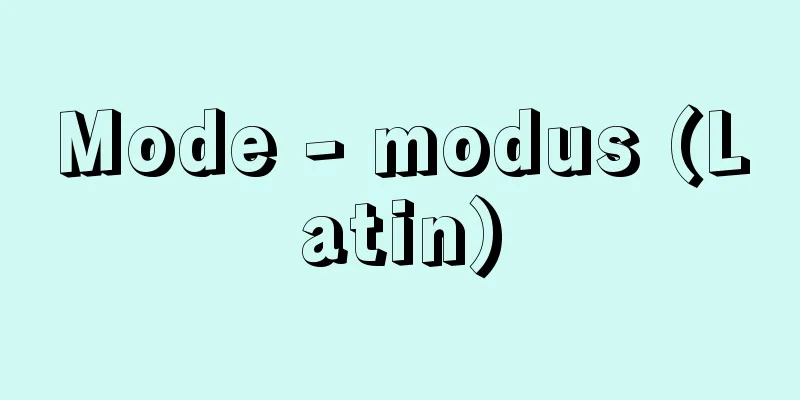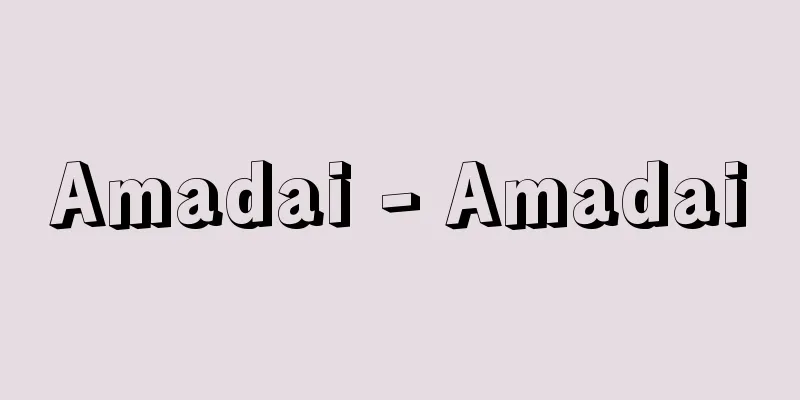Mode - modus (Latin)

|
A term in music theory. A series of tones that further classifies the musical scale, which is a "step of notes," according to the relationship between intervals, the position of the tonic note, the range, and the concept behind it. It can also be said to be a part cut out from a series of tones arranged on a scale. For example, even with the same pentatonic scale, if the relationship between the tones is different, such as Do-Re-Mi-So-La and Do-Re-Fa-So-La, it becomes a different mode, and even with the same pentatonic scale, there are five modes depending on the position of the tonic note. Also, based on the relationship between the tonic note and the range, it can be divided into authentic modes, where the tonic note and the lowest note match, such as church modes, and plagal modes, where they do not match. [Toshiaki Kurosaka] WesternThis system was first theorized in the form of a scale in the 5th and 6th centuries by Boethius and Cassiodorus, but modal systems existed in ancient Greek music as well, where tetrachords (four-tone scales with a perfect fourth at each end) were stacked to form the great perfect system (systema teleion), and an octave was cut from this series to represent seven descending series, or harmonia. In the Middle Ages, church modes were organized to organize the musical phrases of Gregorian chant according to the more important notes. Although it is not possible to trace their development historically, it is believed that by the end of the 9th century, there were eight regular modes (four authentic and four plagal modes). In the mid-16th century, four more modes were added, making a total of twelve modes. The new Aeolian mode corresponds to the modern minor natural scale, and the Ionian mode corresponds to the major scale. For this reason, the modern major and minor scales are sometimes called major and minor modes. Today in Western music, modes are often used either exclusively to refer to church modes, or more broadly to describe musical sequences in archaic or folk music. In addition, the Latin word modus and its derivatives are used to indicate the "manner" of rhythm and other elements other than mode. [Toshiaki Kurosaka] JapanIn gagaku music of the Nara period, the five tones of Kyu, Sho, Kaku, Chi, and U (corresponding to Do, Re, Mi, So, and La) obtained by the sanbun-sen-ho method were used as the basic scale, and four modes were used with the four tones other than U as the tonic notes. During the Heian period, these four modes were divided into two categories: the two modes with Kyu and Shou as the tonic notes were called "Ryo" and the others were called "Ritsu". Later, when the tonic note was placed on Kyu, it was called Ryosen (Ho), and when the tonic note was placed on Sho, it was called Ritsusen (Ho). After the Meiji period, the pentatonic scale without a semitone was called Yang mode, and the pentatonic scale with a semitone was called In mode, and the term mode was used almost synonymously with scale. In response to this, Hisao Tanabe took the Yang scale (the seven-tone scale of Reh-Re) and the In scale (the seven-tone scale of Mi-Mi) as the basic scales, selected three five-tone scales from each, and named them Yang mode and In mode, proposing a unique distinction between scale and mode. However, today, when applying modes to Japanese music, it is limited to the Ritsusen (Ho) and Ryosen (Ho) of Gagaku. [Toshiaki Kurosaka] Folk musicModes are a collective term for musical structures such as Indian raga, Iranian dastgah and 'ābāz, and Arabic and Turkish maqam. These have been considered modes in the sense of a scale with a conventional melodic form, but each is linked to its own unique traditional view of music, and it is difficult to simply call them modes. In recent years, the term mode has come to be used in a general sense, rather than as a strict musicological term, to refer to the tonal structures of other ethnic musics as well. [Toshiaki Kurosaka] [Reference] | | | |Source: Shogakukan Encyclopedia Nipponica About Encyclopedia Nipponica Information | Legend |
|
音楽理論用語。「音の階段」である音階を、音程関係、主音の位置、音域などにより、さらに細かく分類した音列、およびその概念。また、音階上に並べた一連の音列から、一部分を切り取ったものということもできる。たとえば同じ五音音階でも、ド・レ・ミ・ソ・ラとド・レ・ファ・ソ・ラのように、音程関係が異なれば違う旋法となり、同じ音程関係の五音音階でも、主音の位置により5種の旋法となる。また、主音と音域の関係から、教会旋法などのように主音と最低音が一致する正格旋法、一致しない変格旋法に分けられる。 [黒坂俊昭] 西洋最初にこの体系が音階の形で理論づけられたのは、5~6世紀、ボエティウスとカッシオドルスによる音楽理論においてであるが、それに先だつ古代ギリシア音楽にも旋法的なものは存在した。そこでは、テトラコード(両端が完全四度をなす四音音階)を積み重ねて大完全音組織(シュステマ・テレイオン)を形成し、この音列から一オクターブを切り取り、7種の下降形の音列、ハルモニアが表された。 中世に至り、グレゴリオ聖歌の楽句をより重要な音に従って整理する目的で、教会旋法が体系づけられた。その発展段階を歴史的に追うことはできないが、9世紀末には通常の8種類(4種の正格旋法と4種の変格旋法)になったと考えられる。さらに16世紀中ごろ四旋法が加わり、計12の旋法が体系化された。新しいエオリア旋法は、近代の短調の自然的短音階、イオニア旋法は長音階に相当する。そのため、近代の長・短音階を長旋法、短旋法とよぶこともある。 今日、西洋音楽では、旋法を教会旋法に限定したり、さらに広げて古風なまたは民俗的な音楽の音列説明に用いている。 なお、ラテン語のモードゥスおよびその派生言語は、旋法以外にも、リズムその他の要素について「様態」を示すことばとして用いられる。 [黒坂俊昭] 日本奈良時代の雅楽では、三分損益法で得た宮(きゅう)・商(しょう)・角(かく)・徴(ち)・羽(う)(ド・レ・ミ・ソ・ラに相当)の五声を基本音階とし、羽以外の四音を主音とする四旋法を用いた。平安時代に、この四旋法のうち、宮と商を主音とする二旋法を「呂(りょ)」、これ以外を「律(りつ)」と二大別するようになり、のちに宮に主音を置く場合を呂旋(法)、徴に主音を置く場合を律旋(法)と称した。明治以降、半音を含まない五音音階を陽旋法、半音を含む五音音階を陰旋法とよぶなど、旋法は音階とほとんど同義に用いられていた。これに対し田辺尚雄(ひさお)は、陽音階(レ―レの七音音階)と陰音階(ミ―ミの七音音階)を基本音階とし、それぞれから3種の5音音階を選び出して陽旋法、陰旋法と名づけ、音階と旋法の独自の区別を提唱した。しかし今日、旋法を日本音楽に適用する場合は、雅楽の律旋(法)、呂旋(法)に限定している。 [黒坂俊昭] 民族音楽インドのラーガ、イランのダストガーやアーバーズ、アラビアやトルコのマカームなどの音組織を総称して、一般に旋法という。これらは、慣用的な旋律型をもつ音階という意味で旋法とみなされてきたが、それぞれ独自の伝統的音楽観と結び付いており、単純に旋法とはいいがたい。 近年では厳密な音楽学の用語としてではなく、一般的な意味で、その他の民族音楽の音組織をも旋法とよんでいる。 [黒坂俊昭] [参照項目] | | | |出典 小学館 日本大百科全書(ニッポニカ)日本大百科全書(ニッポニカ)について 情報 | 凡例 |
Recommend
Guardian - Shugo
In medieval Japan, a warrior or organization that...
Salamis
…the historic naval battle of 480 BC in the Secon...
Johannes XXII
1249‐1334 Pope of the Roman Empire. Reigned 1316-3...
Galium trachyspermum (English spelling) Galiumtrachyspermum
…[Mr. Makoto Fukuoka]. … *Some of the terminology...
Endless
Endless: Never ending. Infinite. ※NHK Backstage Ta...
Akitsushima
〘Noun〙 (Misreading of " shima " in "...
Turnebus (English spelling)
1512‐65 A French classical scholar. His real name ...
Fundamentals of Agriculture - Nougyoukisoron (English)
The general term for policies decided by the Centr...
Zhou Zuoren - Shu Sakujin
A Chinese prose writer. He was known by many pen ...
Servant - Kenjo
〘Noun〙 In the Nara period, a guard officer was pro...
Republic of China
The republic was established in 1912 after the Xin...
America Guide Series
...In France, the Guide Bleu by Louis Christophe ...
German Music - German Music
The greatness of German music, represented by such...
Ogondai - Ogondai
...A warm-water fish (illustration) of the family...
Ministerial
"Kashi" (household retainer) or "Ke...

![Reuters [company] - Reuters](/upload/images/67cd38038a85f.webp)







